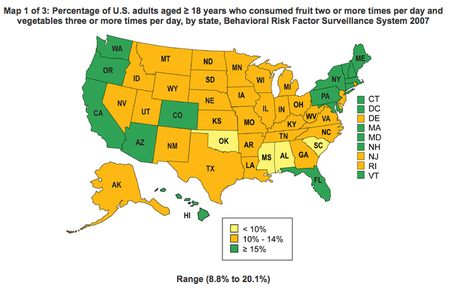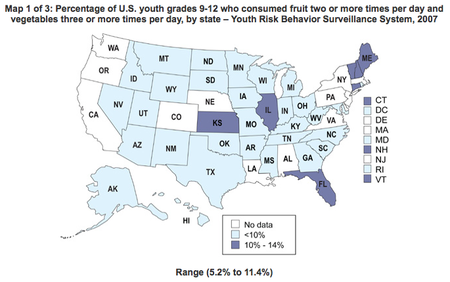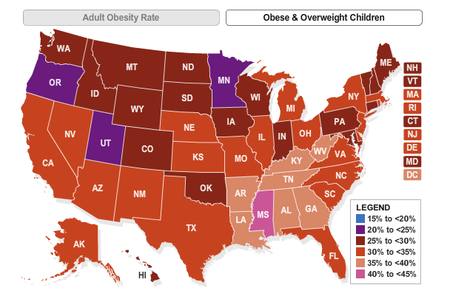The South's fruit and vegetable crisis
You might not think it could happen in the region noted for a cuisine featuring sweet potatoes, greens, okra and watermelon, but a groundbreaking new federal report shows that no U.S. state is meeting national goals for consumption of fruit and vegetables -- and the situation is especially dire in the South.
"State Indicator Report on Fruits and Vegetables, 2009," released last week by the U.S. Centers for Disease Control and Prevention in Atlanta, was the first to look at consumption by state. It found there are four states where fewer than 10% of adults are meeting the recommendations of eating fruit two or more times a day and vegetables three or more times a day -- Alabama, Mississippi and South Carolina in the South as well as the Great Plains state of Oklahoma.
 The situation is even worse for young people, with the study finding that in almost every state in the South for which data was available fewer than 10% youth in grades 9 through 12 were meeting dietary recommendations.
The situation is even worse for young people, with the study finding that in almost every state in the South for which data was available fewer than 10% youth in grades 9 through 12 were meeting dietary recommendations.
 "A diet high in fruits and vegetables is important for optimal child growth, maintaining a healthy weight, and prevention of chronic diseases such as diabetes, heart disease and some cancers, all of which currently contribute to health care costs in the United States," said Dr. William H. Dietz, director of CDC's Division of Nutrition, Physical Activity, and Obesity.
"A diet high in fruits and vegetables is important for optimal child growth, maintaining a healthy weight, and prevention of chronic diseases such as diabetes, heart disease and some cancers, all of which currently contribute to health care costs in the United States," said Dr. William H. Dietz, director of CDC's Division of Nutrition, Physical Activity, and Obesity.
Adult and childhood obesity are big problems in the South. Mississippi has the highest rate of obese adults (32.5%) as well as obese and overweight children ages 10 to 17 (44.4%), according to a report released earlier this year by the Trust for America's Health and the Robert Wood Johnson Foundation.
That report found that eight of the 10 states with the highest rates of obese and overweight children are in the South. Besides Mississippi, they are Alabama, Arkansas, Georgia, Kentucky, Louisiana, Tennessee and West Virginia.
 The CDC study also looked at ways to encourage purchase and consumption of healthier food, such as state policies to encourage retailers to offer healthier foods. Only eight states currently have such a retail policy, and only one -- Louisiana -- is in the South, with another such policy pending in West Virginia.
The CDC study also looked at ways to encourage purchase and consumption of healthier food, such as state policies to encourage retailers to offer healthier foods. Only eight states currently have such a retail policy, and only one -- Louisiana -- is in the South, with another such policy pending in West Virginia.
Another policy approach for improving fruit and vegetable consumption is through state-level farm-to-school policies that help bring fresh foods to school dining programs. Among the 21 states that have such policies only four are in the South: Kentucky, Tennessee, Texas and Virginia, with similar policies pending in Georgia and South Carolina.
"We have seen the tremendous benefit of state and local officials, health professionals, employers, food store owners, farmers, school staff, and community members working together on food and nutrition issues," said CDC epidemiologist Heidi Michels Blanck. "Their efforts can help to increase the availability of affordable healthier food choices such as fruits and vegetables."
(First two maps from CDC's "State Indicator Report on Fruits and Vegetables, 2009"; third from "F as in Fat: How Obesity Policies Are Failing in America 2009.")
"State Indicator Report on Fruits and Vegetables, 2009," released last week by the U.S. Centers for Disease Control and Prevention in Atlanta, was the first to look at consumption by state. It found there are four states where fewer than 10% of adults are meeting the recommendations of eating fruit two or more times a day and vegetables three or more times a day -- Alabama, Mississippi and South Carolina in the South as well as the Great Plains state of Oklahoma.
 The situation is even worse for young people, with the study finding that in almost every state in the South for which data was available fewer than 10% youth in grades 9 through 12 were meeting dietary recommendations.
The situation is even worse for young people, with the study finding that in almost every state in the South for which data was available fewer than 10% youth in grades 9 through 12 were meeting dietary recommendations. "A diet high in fruits and vegetables is important for optimal child growth, maintaining a healthy weight, and prevention of chronic diseases such as diabetes, heart disease and some cancers, all of which currently contribute to health care costs in the United States," said Dr. William H. Dietz, director of CDC's Division of Nutrition, Physical Activity, and Obesity.
"A diet high in fruits and vegetables is important for optimal child growth, maintaining a healthy weight, and prevention of chronic diseases such as diabetes, heart disease and some cancers, all of which currently contribute to health care costs in the United States," said Dr. William H. Dietz, director of CDC's Division of Nutrition, Physical Activity, and Obesity.Adult and childhood obesity are big problems in the South. Mississippi has the highest rate of obese adults (32.5%) as well as obese and overweight children ages 10 to 17 (44.4%), according to a report released earlier this year by the Trust for America's Health and the Robert Wood Johnson Foundation.
That report found that eight of the 10 states with the highest rates of obese and overweight children are in the South. Besides Mississippi, they are Alabama, Arkansas, Georgia, Kentucky, Louisiana, Tennessee and West Virginia.
 The CDC study also looked at ways to encourage purchase and consumption of healthier food, such as state policies to encourage retailers to offer healthier foods. Only eight states currently have such a retail policy, and only one -- Louisiana -- is in the South, with another such policy pending in West Virginia.
The CDC study also looked at ways to encourage purchase and consumption of healthier food, such as state policies to encourage retailers to offer healthier foods. Only eight states currently have such a retail policy, and only one -- Louisiana -- is in the South, with another such policy pending in West Virginia.Another policy approach for improving fruit and vegetable consumption is through state-level farm-to-school policies that help bring fresh foods to school dining programs. Among the 21 states that have such policies only four are in the South: Kentucky, Tennessee, Texas and Virginia, with similar policies pending in Georgia and South Carolina.
"We have seen the tremendous benefit of state and local officials, health professionals, employers, food store owners, farmers, school staff, and community members working together on food and nutrition issues," said CDC epidemiologist Heidi Michels Blanck. "Their efforts can help to increase the availability of affordable healthier food choices such as fruits and vegetables."
(First two maps from CDC's "State Indicator Report on Fruits and Vegetables, 2009"; third from "F as in Fat: How Obesity Policies Are Failing in America 2009.")
Tags
Sue Sturgis
Sue is the former editorial director of Facing South and the Institute for Southern Studies.
